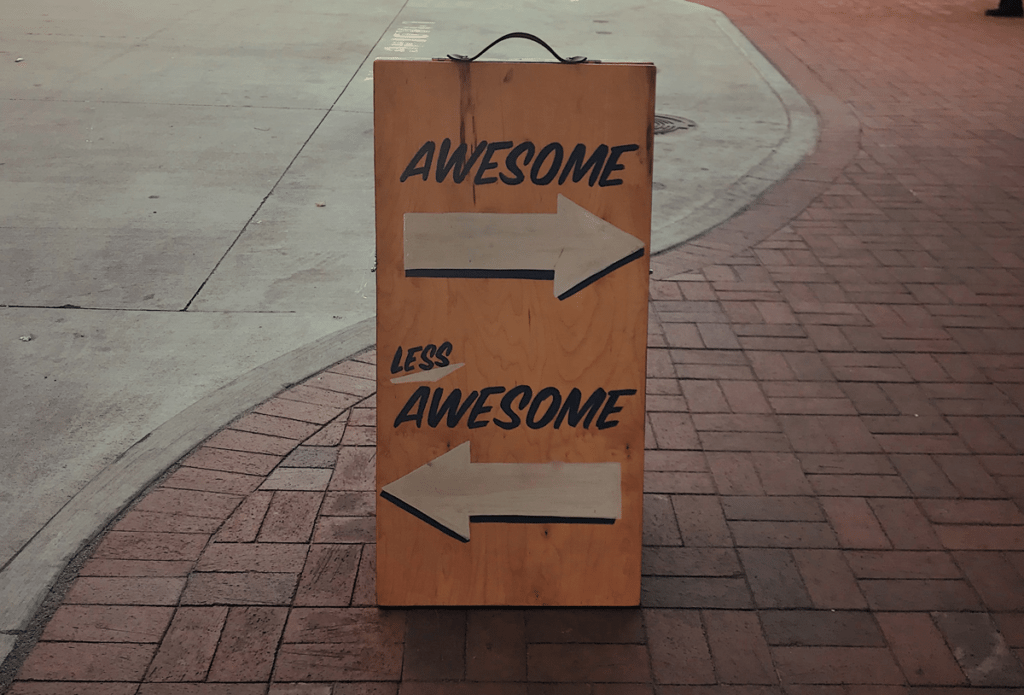UX in the customer journey
Customer journey doesn’t start with the purchase, but with designers and their ideas on how this process should look like. Customer journey and customer experience are two inextricable processes linked with the design. Exactly for that reason, it’s important to think of customer experience and journey in the design phase and tailor the end product for the user a.k.a customer. To facilitate this process and to get closer to the users, designers can use UX laws which are connected with human behavior and psychology.
The customer journey is a process with numerous different phases which have to be planned and included. The first one is raising awareness about a product or service. It’s oriented towards introducing customers to the product. If users don’t know anything about your product or service, they won’t consider buying it. This phase is also called ‘’I need’’ phase when users estimate whether they require something or not.
The second phase of the customer journey is the user’s consideration to make a purchase. This phase occurs only when users are familiar with what you have to offer. It’s also the research stage when customers consider purchasing based on the information you provide or rely on reviews of other users.
After the consideration and research phase comes the decision or purchase phase when customers are ready to buy a product or service. It may seem that the first two phases are the hardest and most complicated. Well, it isn’t. If your customer wants to spend money in your shop, there’s a possibility that he or she will give up if there are any unnecessary steps through the shopping and payment process. It may occur that they will be annoyed by the ordering, registration or payment process, and there’s the possibility of abandoning the purchase just a click before submitting the button. Here comes the importance of customer journey and UX or UI elements.
If the purchase process is successful, then so are subsequent phases of retention and advocacy of the purchased product. But… if the purchase hasn’t been made, it can be a warning signal about a faulty customer journey and customer experience. In order to get to the end of this problem and improve user experience, there are a few ways and principles that can be used for improving customer experience through design, content architecture and proper UI implementation.
Customer journey should be planned and implemented not solely by designers and developers, but also marketing team which specializes in online sale. With that said, there are laws that should be used in order to simplify and improve the buying process and overall user experience.
FITT’S LAW
The time to acquire a product is a combination of the distance to and size of its position. Make elements (you wish to be easily selectable) large and position them to be accessible just a few clicks away. This law especially applies to buttons, which have the purpose to be easily found and selectable.
Fitt’s law is widely applied in user experience (UX) and user interface (UI) design. For example, this law influenced the convention of making interactive buttons large (especially on finger-operated mobile devices) because smaller buttons are more difficult (and time-consuming) to click. Likewise, the distance between a user’s task attention area and the task-related button should be kept as short as possible.
HICK’S LAW

The time it takes to make a decision increases with the quantity and complexity of choices. More choices result in longer thinking about purchasing a product and making a decision. Simplify options for the user by dividing complex tasks into smaller steps. Avoid overwhelming your customers by highlighting recommended options. This law is examining the relationship between the number of stimuli present and an individual’s reaction time to any given option. As you would expect, the more stimuli to choose from, the longer it takes the user to make a decision on which one to interact with. Users bombarded with choices have to take time to interpret and decide.
JAKOB’S LAW

Users spend most of their time on other sites. This means that users prefer your site to work the same way as all the other sites they already know. It means that your customer journey process should look similar to other webshops and pages. It doesn’t have to look identically the same, just intuitive enough so customers can deal with the purchasing process. You can simplify the navigation process for users simply by providing familiar design patterns. Jakob’s law is based on the ‘discount usability engineering’ movement for fast and cheap improvements of user interfaces and has brought several usability methods, including heuristic evaluation ie. any approach to problem-solving, learning, or discovery that employs a practical method not guaranteed to be optimal or perfect, but sufficient for the immediate goals. Where finding an optimal solution is impossible or impractical, heuristic methods can be used to speed up the process of finding a satisfactory solution.
LAW OF PRAGNANZ
People will perceive and interpret ambiguous or complex images in the simplest form possible because it is the interpretation that requires the least cognitive effort. The human eye likes to find simplicity and order in complex shapes because it prevents us from becoming overwhelmed with information.

It is similar to how the lights encircling a movie theater marquee flash on and off. To the observer, it appears as if a single light moves around the marquee, traveling from bulb to bulb, when in reality it’s a series of bulbs turning on and off and the lights don’t move at all. This observation led to a set of descriptive principles about how we visually perceive objects. These principles sit at the heart of nearly everything we, as designers, do graphically.
LAW OF PROXIMITY
Objects that are near, or proximate to each other, tend to be grouped together. The law of proximity is useful by allowing users to group different clusters of content at a glance. The principles of grouping are a set of principles in psychology, first proposed by Gestalt psychologists, to account for the observation that humans naturally perceive objects as organized patterns and objects – a principle known as Prägnanz.
Gestalt psychologists argued that these principles exist because the mind has a native disposition to perceive patterns in the stimulus based on certain rules. These principles are organized into five categories: Proximity, Similarity, Continuity, Closure, and Connectedness.
LAW OF SIMILARITY

The human eye tends to perceive similar elements in a design as a complete picture, shape, or group, even if those elements are separated. Ensure that links and navigation systems are visually differentiated from normal text elements, and are consistently styled. This is also (as is the case with the law of proximity) connected with human abilities to perceive patterns in the stimulus based on certain rules. These principles are organized into five categories: Proximity, Similarity, Continuity, Closure, and Connectedness.
MILLERS’S LAW
The average person can only keep 7 (plus or minus 2) items in their working memory. “Chunking” is an effective method of presenting groups of content in a manageable way. Organize content in groups of 5-9 items at a time. The span of immediate memory and absolute judgment were both limited to around 7 pieces of information. The point where confusion creates an incorrect judgment is the channel capacity. In other words, the number of bits that can be transmitted reliably through a channel, within a certain amount of time.
OCCAM’S RAZOR

Among competing hypotheses that predict equally well, the one with the fewest assumptions should be selected. Analyze each element and remove as many as possible, without compromising the overall function. This is also known as “law of parsimony” a problem-solving principle that, when presented with competing for hypothetical answers to a problem, a customer should select the one that makes the fewest assumptions.
PARETO PRINCIPLE
Its origins stem back to Vilfredo Pareto, an economist who noticed 80% of Italy’s land was owned by 20% of the population. The Pareto principle states that, for many events, roughly 80% of the effects come from 20% of the causes. Focus the majority of your efforts on the areas that will bring the largest benefits to the most users. Though it might seem vague, the 80/20 way of thinking can provide insightful and endlessly applicable analysis of lopsided systems, including user experience strategy.
PARKINSON’S LAW
The importance of Parkinson’s Law lies in the fact that it is a law of growth based upon an analysis of the factors by which that growth is controlled. The fact is that the number of the people and the quantity of the work which needs to be done are not related to each other at all. Solving this problem is achieved by good organization of work, in this case by good organization of UX elements. Parkinson also proposed a rule about the efficiency of administrative councils.

He defined a “coefficient of inefficiency” with the number of members as the main determining variable. This is a semi-humorous attempt to define the size at which a committee or other decision-making body becomes completely inefficient. The same thing goes for the process of implementing UX elements – the more elements you want to implement, the less efficient your app or webpage will be and users will need more time for managing the application.
SERIAL POSITION EFFECT
Users have a propensity to best remember the first and last items in a series. Placing the least important items in the middle of lists can be helpful because these items tend to be stored less frequently in long-term and working memory. Positioning key actions on the far left and right within elements such as navigation can increase memorization.
The serial position effect describes how the position of an item in a sequence affects recall accuracy. The two concepts involved, the primacy effect and the recency effect, explain how items presented at the beginning of a sequence and the end of a sequence are recalled with greater accuracy than items in the middle of a list. Manipulation of the serial position effect to create better user experiences is reflected in many popular designs by successful companies like Apple, Electronic Arts, and Nike.
TESLER’S LAW
Tesler’s Law, also known as The Law of Conservation of Complexity, states that for any system there is a certain amount of complexity which cannot be reduced. The way users interact with applications was just as important as the application itself. In most cases, an engineer should spend an extra week reducing the complexity of an application versus making millions of users spend an extra minute using the site because of the extra complexity. When an application is simplified, users begin attempting more complex tasks.
VON RESTORFF EFFECT

The Von Restorff effect, also known as The Isolation Effect, predicts that when multiple similar objects are present, the one that differs from the rest is most likely to be remembered. Make important information or key actions visually distinctive. When participants are presented with a list of categorically similar items with one distinctive, isolated item on the list, memory for the item improves.
ZEIGARNIK EFFECT
People remember uncompleted or interrupted tasks better than completed tasks. Use progress bars for complex tasks to visually indicate when a task is incomplete, and thus increase the likelihood it will be completed.
With continuous tension, the relevant information is becoming more accessible and more easily remembered. For example, students who temporarily stop their studies, during which they do unrelated activities (such as studying unrelated subjects or playing games), will remember the material better than students who complete study sessions without a break. As people sense progression is occurring, the time it takes them to complete the task will also decrease, positively influencing the speed of use of your design. Use abstract currency (like points, coins, credit, gems, elixir etc.) to guide the users through the process of completing a task instead of real actions (like check-ins, tutorials, messages, rides etc.).







